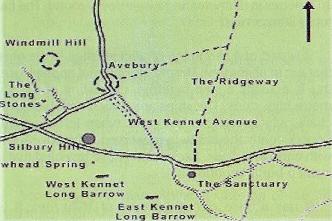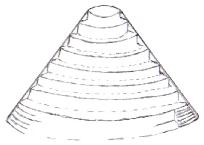AVEBURY – MYSTERIOUS STONE CIRCLES
Editorial Note: In spite of much scholarly work on the ancient pre-historic inhabitants of Britain, which has, in recent years, entirely refuted the entrenched idea that they were “woad painted savages”, the idea persists. Dr Frances Prylor has written several very good books on the subject, proving that our ancestors had a highly developed civilisation, dating back thousands of years. The following article reinforces this view, as it dates Avebury and Silbury to earlier than the Pyramids of Egypt. It demonstrates the considerable skills and knowledge required for the construction of such monuments. Carbon dating places Silbury Hill at 2,600 B.C. and Avebury stone circle about 100 years later.
THE village of Avebury in Wiltshire, which lies in the heart of the Wiltshire Downs, ninety miles west of London and twenty miles north of Stonehenge contains one of the greatest stone circles in the British Isles. It may be the largest known stone ring in the world – athough there is no proof.
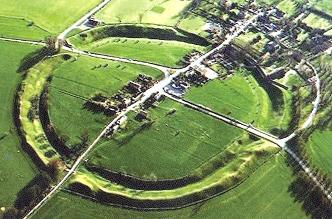 Older than the more famous Stonehenge, and for many visitors far more spectacular, the multiple rings of Avebury are cloaked with mysteries which archaeologists have only begun to unravel. Some people believe there is an extra-terrestrial link.
Older than the more famous Stonehenge, and for many visitors far more spectacular, the multiple rings of Avebury are cloaked with mysteries which archaeologists have only begun to unravel. Some people believe there is an extra-terrestrial link.
Avebury stone circles are thought to have been constructed in neolithic times between 2,500 to 2,000 B.C.
The ‘Beaker people’ – so called after their pottery – are thought to have played a major role in their formation, as they did with Stonehenge. Similar to Stonehenge and many other megalithic monuments in the British Isles, Avebury is a composite construction that was added to and altered during several periods.
As the site currently exists, the great circle consists of a grass-covered, chalk-stone bank that is 1,396 feet in diameter (427 metres) and 20 feet high (6 metres) with a deep inner ditch having four entrances at the cardinal compass points.
Just inside the ditch, which was clearly not used for defensive purposes, lies a grand circle of massive and irregular sarsen stones enclosing approximately 28 acres of land.
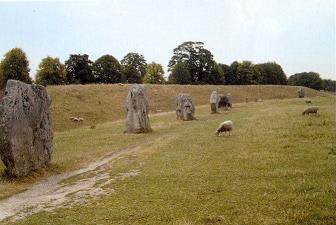 This circle, originally composed of at least 98 stones but now having only 27, itself encloses two smaller stone circles, each being about 340 feet (104 metres) in diameter. The two inner circles are believed to have been constructed first, around 2,600 B.C., while the large outer ring and earthwork dates from 2,500 B.C.
This circle, originally composed of at least 98 stones but now having only 27, itself encloses two smaller stone circles, each being about 340 feet (104 metres) in diameter. The two inner circles are believed to have been constructed first, around 2,600 B.C., while the large outer ring and earthwork dates from 2,500 B.C.
The construction of the Avebury complex must have required enormous efforts on the part of the local inhabitants. The sarsen stones, ranging in height from nine to over twenty feet and weighing as much as 40 tons, were first hewn from bedrock and then dragged or sledded a distance of nearly two miles from their quarry site.
These stones were then erected and anchored in the ground to depths between 6 and 24 inches. The excavation of the encircling ditch required an estimated 200,000 tons of rock to be chipped and scraped away with the crudest of stone tools and antler picks (there is some evidence that this ditch was once filled with water, thereby giving the inner stone rings the appearance of being set upon an island).
From excavation and soil resistivity studies it is known that the three rings originally contained at least 154 stones of which only 36 remain standing today.
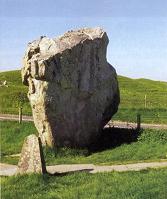 Only about 100 great sarsen stones and local sandstone from Marlborough Downs, still stand. There are three reasons for the disappearance of the other stones. In the 14th century, and perhaps earlier, the local Christian authorities, in their continuing effort to eradicate any vestiges of ‘pagan’ religious practices, toppled, broke up and buried many of the stones.
Only about 100 great sarsen stones and local sandstone from Marlborough Downs, still stand. There are three reasons for the disappearance of the other stones. In the 14th century, and perhaps earlier, the local Christian authorities, in their continuing effort to eradicate any vestiges of ‘pagan’ religious practices, toppled, broke up and buried many of the stones.
Later, in the 17th and 18th centuries, still more of the remaining stones were removed from their foundations. Crops could then be planted in these areas and the massive stones could be broken into smaller pieces to be used for the construction of houses and other buildings.
SILBURY HILL
Silbury Hill is a massive artificial mound with a flat top. It is the tallest man-made prehistoric mound in Europe. It is part of the complex of Neolithic monuments located just south of the villageof Avebury in Wiltshire.
Recent excavations have allowed us to discover that the people who created it actually layered it in a three-part process similar to how we would create a battery.Silbury Hill may have been created as a ‘natural Earth battery’ .
 Silbury Hill has been carbon-dated at 2,660 years B.C., the same era as the Giza pyramids. It contains an estimated 340,000 cubic metres of chalk and earth, rising to a height of 39.6 metres. The base of the monument is 167 metres in diameter and it is perfectly round. The flat top is 30 metres across.
Silbury Hill has been carbon-dated at 2,660 years B.C., the same era as the Giza pyramids. It contains an estimated 340,000 cubic metres of chalk and earth, rising to a height of 39.6 metres. The base of the monument is 167 metres in diameter and it is perfectly round. The flat top is 30 metres across.
It is part of a sequence of ancient sites in the area that are in alignment. Despite its external appearance, this is actually a step pyramid, consisting of six, six metre high steps. The steps are walled with blocks of chalk, which easily deteriorates when left exposed. Consequently the builders preserved it, by covering it with earth and grass. Excavations have revealed that it is not a burial mound.
It has a base circumference of 1,640 feet. It is composed of over 12 million cubic feet (339,600 cubic metres) of chalk and earth and covers over 5 acres (2 hectares). Silbury Hill occupies a low-lying site and except at certain points in the landscape (notably from the West Kennet Long Barrow), it does not protrude significantly above the horizon.
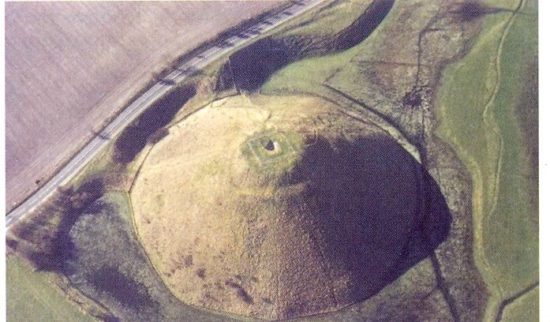 It was built in three stages, the first begun around 2,660 B.C.E. The last phase comprised the building of six concentric steps or terraces of chalk which were then covered with chalk rubble, flints, gravel, and finally soil to form a cone-shaped mound. Each of the six steps was concealed within the overall profile of the mound, except the last one at the top which was left as a terrace or ledge about 17 feet (5 metres.) below the summit. This terrace is clearly visible on the eastern side of the mound, but less distinct from the west.
It was built in three stages, the first begun around 2,660 B.C.E. The last phase comprised the building of six concentric steps or terraces of chalk which were then covered with chalk rubble, flints, gravel, and finally soil to form a cone-shaped mound. Each of the six steps was concealed within the overall profile of the mound, except the last one at the top which was left as a terrace or ledge about 17 feet (5 metres.) below the summit. This terrace is clearly visible on the eastern side of the mound, but less distinct from the west.
Various legends have been attached to Silbury Hill.
Silbury Grassed Over Conical Step Pyramid
Folklore has claimed it to be the burial place of an otherwise forgotten King Sil (or ZeI); of a knight in golden armour; and even of a solid gold horse and rider. It is also told that the Devil was going to empty a huge sack of earth on the town of Marlborough, but was forced to drop it here by the magic of the priests from nearby Avebury.
According to William Stukeley, the top of the hill was dug into in 1,723 and some bones were discovered together with an ancient bridle. The mound was again dug into in 1,776 and in 1,849. In 1,967, excavations were undertaken by Richard Atkinson but again neither burials nor any clue to the mound’s meaning were discovered. Atkinson did learn, however, through radiocarbon analysis that the mound dates to around 2,660 B.C.
Further evidence from the remains of plants and insects indicated that the structure was begun during the first week in August, probably at the time of the Celtic festival of Lugnasadh (or Lammas) at the start of the harvest season.
In a drawing of part of the Sanctuary made by William Stukeley in 1,723, Silbury can clearly be seen in the background, its summit in line with the horizon.
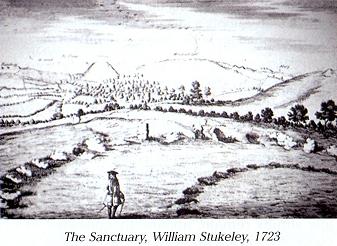 The very top of the mound can also be discerned from the village of Avebury in what has been described as a precise geomantic relation with the so-called ‘Obelisk’ in the Avebury complex. It can be seen, however, only after the crops in the intervening field on the horizon have been harvested; the standing grain is sufficient to obscure the view. For some, this is further evidence for interpreting the mound in connection with harvest festivals.
The very top of the mound can also be discerned from the village of Avebury in what has been described as a precise geomantic relation with the so-called ‘Obelisk’ in the Avebury complex. It can be seen, however, only after the crops in the intervening field on the horizon have been harvested; the standing grain is sufficient to obscure the view. For some, this is further evidence for interpreting the mound in connection with harvest festivals.
The original purpose of Silbury is unknown, although various explanations have been put forward over the years. Recently, Michael Dames has suggested that the hill is a symbolic effigy of the ancient Mother Goddess and is to be associated with fertility rituals which marked the course of the year. The festival of Lugnasadh (or Lammas) in August, when it is thought Silbury was founded, celebrates the first fruits of the harvest. It has been pointed out that the spring which rises five hundred yards south of the hill and is the source of the River Kennet,was formerly called the Cunnit, a name followed a pre-existing track or ley line.
John Michell makes the following observations:
“In view of the fact that in China mounds like that at Silbury were erected upon lung-mei, the paths of the dragon, there is good reason to suspect that Silbury itself was sited by Pre-Celtic Druids on a dragon line with the assistance of a geomancer’s compass. It may also be inferred that the Chinese lung-mei stretch over the entire globe. Many centres of English dragon legend stand at the junction of well-marked leys, one notable long-distance example being the St Michael’s line that runs from the Avebury circle to the extreme west of Cornwall.”
In the early 18th century, William Stukeley visited the site on several occasions and witnessed, to his great distress, the destruction of numerous stones by farmers intent on clearing the land for fields. Stukeley agreed with Aubrey’s identification of the site and in 1,743 published his book Avebury, a Temple of the British Druids.
Mostly dating to around 2,600-2,500 B.C., the Avebury complex, which covers about 28 acres and is partially overlapped by the village, comprises a huge circular earthwork ditch, originally about 30 feet deep, and bank about a quarter of a mile in diameter which encloses an outer circle of standing stones. Within this outer circle are two inner circles, both about 340 feet in diameter. The northern inner circle, of which only a few stones remain, apparently consisted of two concentric circles; an inner one of 12 stones and an outer one of 27 stones. At the centre of the northern circle stood a trio of very large stones, two of which survive, called The Cove.
West Kennet Avenue
 At the centre of the southern circle stood a tall stone over 20 feet in length called “the obelisk.” It had already fallen when William Stukeley saw, and drew it, in the 18th century, and is now gone altogether. This site, as with the other missing stones at Avebury, is now marked by a concrete pillar.
At the centre of the southern circle stood a tall stone over 20 feet in length called “the obelisk.” It had already fallen when William Stukeley saw, and drew it, in the 18th century, and is now gone altogether. This site, as with the other missing stones at Avebury, is now marked by a concrete pillar.
The northern and southern inner stone circles are believed to have been built first, around 2,600 B.C. ,and the outer circle and the earthworks added about a hundred years later, around 2,500 B.C. The outer circle is breached at four points – roughly at points north, south, east, and west – to form entrances. From two of these originally ran two great avenues of which only the one, leading from the south entrance, the so-called “West Kennet Avenue”, survives for a short way in reconstructed form with stones lining its course on both sides.
Originally, according to Stukeley, the West Kennet Avenue stretched all the way to the Sanctuary on Overton Hill, while the other, the Beckhampton Avenue, of which very little survives, terminated near the Beckhampton Long Barrow.
Stukeley interpreted the avenues as representing a great stone serpent passing through a ring formed by the Avebury circle.
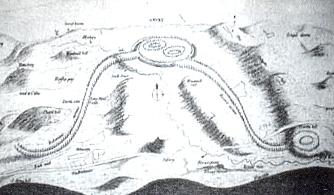 William Stuckeley’s ‘great stone serpent’
William Stuckeley’s ‘great stone serpent’
Silbury can be seen in the background.
But Avebury is more than just a stone circle – although this is its main feature. There is also a rampart, a ditch and two mysterious avenues. The rampart or bank is on the outside, then comes the ditch. They both have four entrances and enclose some twenty eight acres. Inside these ‘circles’ – none of the circumferences are perfect – is the stone circle itself.
It once consisted of around one hundred unquarried stones; inside this larger circle were once two smaller circles. Only four stones of one of the smaller circles survive, although it is thought there may have once been as many as twenty seven. None of the stones in the other small circle are now standing, although it is thought to have consisted of around twenty nine stones at one time.

